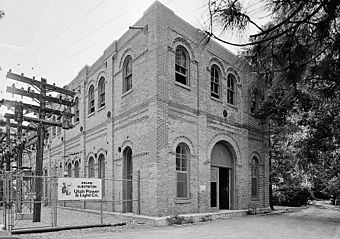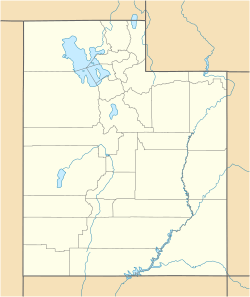Stairs Station Hydroelectric Power Plant Historic District facts for kids
Quick facts for kids |
|
|
Stairs Station Hydroelectric Power Plant Historic District
|
|

Stairs Power Station in 1971
|
|
| Location | Big Cottonwood Canyon Salt Lake County, Utah United States |
|---|---|
| Nearest city | Cottonwood Heights |
| Area | 6.4 acres (2.6 ha) |
| Built | 1896 |
| Built by | Big Cottonwood Power Company |
| Architect | Jones, R.M. |
| Architectural style | Renaissance style |
| MPS | Electric Power Plants of Utah MPS |
| NRHP reference No. | 89000284 |
| Added to NRHP | April 20, 1989 |
The Stairs Station Hydroelectric Power Plant is a historic building in Big Cottonwood Canyon, Utah. It was built a long time ago, between 1894 and 1895. This power plant helped bring electricity to homes and businesses. It is about 8 miles (13 km) southeast of Salt Lake City.
This special power plant includes the main building (called the powerhouse), an area for electrical switches, and large pipes. These pipes, called penstocks, carry water. The powerhouse is the only part of the original plant that is still standing today. It shows how electricity was made using water power in the late 1800s.
Contents
How the Stairs Station Makes Power
The Stairs Station uses water to create electricity. This is called hydroelectric power. When it was first built, it had four special machines called Pelton wheels. These wheels spun when water rushed through them.
From Water Wheels to Modern Turbines
Today, the plant uses a single, more modern machine. It is called a Francis turbine. This turbine can make 1.2 megawatts of electricity. That's enough power for many homes! The building itself has two levels. The lower level holds the big machines that make power. The upper level used to hold the equipment that controlled the electricity.
The Journey of Water to the Plant
For many years, water for the plant came from a place called Storm Mountain Dam. This dam was built in 1921. It replaced an older dam that was higher up in the canyon. The dam was like a small wall, about 10 feet (3.0 m) to 20 feet (6.1 m) tall. It was also about 500 feet (150 m) long.
Water from the dam flowed through a long steel pipe. This pipe was about 1,200-foot (370 m) long. It led to the penstock, which is a very strong pipe. The penstock is about 1,750 feet (530 m) long. It carries the water downhill with great force to spin the turbine at the power plant.
History of the Stairs Station
The Stairs Station was designed by a person named Robert M. Jones. He worked for a company called Big Cottonwood Power Company. Building the plant cost a lot of money back then, about $325,000.
Providing Power to Salt Lake City
In 1895, the Big Cottonwood Power Company made a deal. They agreed to provide electricity to another company in Salt Lake City. This company was called the Salt Lake and Ogden Gas and Electric Company. This helped bring electric lights and power to the area.
Changes Over Time
A few years later, in 1897, the Big Cottonwood company joined with another company. It became part of the Union Light and Power Company in 1899. At some point, a house where the plant operator lived was taken down. We don't know exactly when this happened.
A Historic Landmark
The Stairs Station is an important piece of history. Because of its importance, it was added to the National Register of Historic Places on April 20, 1989. This means it is recognized as a special place that should be protected.



